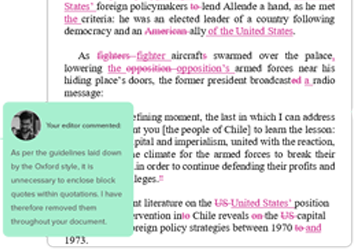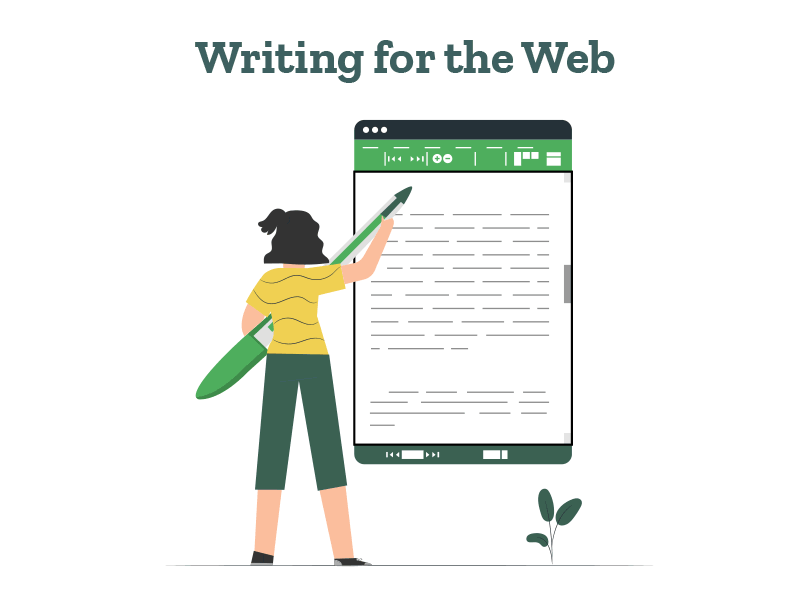- Tips to Self-Edit Your Dissertation
- Guide to Essay Editing: Methods, Tips, & Examples
- Journal Article Proofreading: Process, Cost, & Checklist
- The A–Z of Dissertation Editing: Standard Rates & Involved Steps
- Research Paper Editing | Guide to a Perfect Research Paper
- Dissertation Proofreading | Definition & Standard Rates
- Thesis Proofreading | Definition, Importance & Standard Pricing
- Research Paper Proofreading | Definition & Standard Rates
- Essay Proofreading | Options, Cost & Checklist
- Top 10 Paper Editing Services of 2024 (Costs & Features)
- Top 10 Essay Checkers in 2024 (Free & Paid)
- Top 10 English Correctors to Perfect Your Text in 2024
- 10 Advanced AI Text Editors to Transform Writing in 2024
- Personal Statement Editing Services: Craft a Winning Essay
- College Essay Review: A Step-by-Step Guide (With Examples)
- Top 10 College Essay Review Services: Pricing and Benefits
- How to Edit a College Admission Essay (8-Step Guide)
- Improve Academic Writing: Types, Tips, Examples, Services
- How to Use AI to Write Research Papers: A Step-by-Step Guide
- How to Write an Assignment: A Step-by-Step Guide for Students
- AI Proofreading Services: Meaning, Benefits & Best Tools
- 10 Best Proofreading Services Online for All in 2025
- Top 10 Recommendation Letter Editing Services | Best Picks
- How to Format an Appendix: APA and MLA
- Top 10 Online Thesis Editing and Proofreading Services
- What is Academic Editing? Meaning, Types & Importance
- Top 10 AI Proofreaders to Perfect Your Writing in 2025
- What Is a Thesis: How to Write a Thesis with Examples
- Top 10 Academic Proofreading Services (2025 Update)
- Research Paper Outline: Free Templates & Examples to Guide You
- How to Write a Research Paper: A Step-by-Step Guide
- How to Write a Lab Report: Examples from Academic Editors
- Research Methodology Guide: Writing Tips, Types, & Examples
- The 10 Best Essential Resources for Academic Research
- 100+ Useful ChatGPT Prompts for Thesis Writing in 2024
- Best ChatGPT Prompts for Academic Writing (100+ Prompts!)
- Sampling Methods Guide: Types, Strategies, and Examples
- Independent vs. Dependent Variables | Meaning & Examples
- Understanding Verbatim Plagiarism: Copy, Paste, Regret
- What Is a Journal Article and How to Write a Journal Article
- How to Use AI to Write Research Papers: A Step-by-Step Guide
- Top 10 AI Tools for Research in 2025 (Fast & Efficient!)
- What Is a Research Proposal: A Detailed Guide
- How to Format an Appendix: APA and MLA
- What Is an Appendix In a Paper?
- Types of Journals in Research and Their Features
- How to Write a Research Proposal (Step-by-Step)
- How to Cite an Artwork: APA, MLA, & Chicago
- Difference Between Paper Editing and Peer Review
- How to Handle Journal Rejection: Essential Tips
- Editing and Proofreading Academic Papers: A Short Guide
- How to Carry Out Secondary Research
- The Results Section of a Dissertation
- Final Checklist: Is My Article Ready for Submitting to Journals?
- Types of Research Articles to Boost Your Research Profile
- How does LaTeX based proofreading work?
- How to Improve Your Scientific Writing: A Short Guide
- Chicago Title, Cover Page & Body | Paper Format Guidelines
- How to Write a Thesis Statement: Examples & Tips
- Chicago Style Citation: Quick Guide & Examples
- Research Paper Outline: Free Templates & Examples to Guide You
- The A-Z Of Publishing Your Article in A Journal
- What is Journal Article Editing? 3 Reasons You Need It
- How to Cite a Book in APA Style | Format & Examples
- How to Start a Research Paper | Step-by-step Guide
- APA Citations Made Easy with Our Concise Guide for 2024
- A Step-by-Step Guide to APA Formatting Style (7th Edition)
- Academic Writing in 2024: 5 Key Dos & Don’ts + Examples
- How to Write a Lab Report: Examples from Academic Editors
- What Are the Standard Book Sizes for Publishing Your Book?
- MLA Works Cited Page: Quick Tips & Examples
- 2024’s Top 10 Thesis Statement Generators (Free Included!)
- Top 10 Title Page Generators for Students in 2024
- What Is an Open Access Journal? 10 Myths Busted!
- Primary vs. Secondary Sources: Definition, Types & Examples
- How To Write a College Admissions Essay That Stands Out
- APA Journal Citation: 7 Types, In-Text Rules, & Examples
- What Is Predatory Publishing and How to Avoid It!
- Independent vs. Dependent Variables | Meaning & Examples
- How to Write a Strong Dissertation & Thesis Introduction
- How to Cite a Book in MLA Format (9th Edition)
- How to Cite a Website in MLA Format | 9th Edition Rules
- 10 Best AI Conclusion Generators (Features & Pricing)
- Top 10 Academic Editing Services of 2024 [with Pricing]
- How to Create the Perfect Thesis Title Page in 2024
- What Is Accidental Plagiarism & 9 Prevention Strategies
- What Is Self-Plagiarism? (+ 7 Prevention Strategies!)
- Understanding Verbatim Plagiarism: Copy, Paste, Regret
- Improve Academic Writing: Types, Tips, Examples, Services
- What Is a Journal Article and How to Write a Journal Article
- What Is Paraphrasing Plagiarism and How to Avoid It
- What Is Expository Writing? Types, Examples, & 10 Tips
- Academic Research Ethics & Rules Simplified for All
- Complete Guide to MLA 9th Format
- Top 10 Online Dissertation Editing Services of 2025
- How to Write a Dissertation & Thesis Conclusion (+ Examples)
- What Is a Peer Review & 8 Types of Peer Review Processes
- 50 Best Essay Prompts for College Students in 2025
- What Is an Annotated Bibliography & Writing One Using AI
- What Is an Appendix In a Paper?
- Types of Journals in Research and Their Features
- 5 Effective Personal Statement Examples & Templates
- 100+ Writing Prompts for College Students (10+ Categories!)
- What Is a Thesis: How to Write a Thesis with Examples
- What Is Plagiarism? Meaning, Types & Examples
- How to Write a Research Proposal (Step-by-Step)
- Preventing Plagiarism in Your Thesis: Tips & Best Practices
- Final Submission Checklist | Dissertation & Thesis
- 7 Useful MS Word Formatting Tips for Dissertation Writing
- How to Write a MEAL Paragraph: Writing Plan Explained in Detail
- How does LaTeX based proofreading work?
- Em Dash vs. En Dash vs. Hyphen: When to Use Which
- 2024’s Top 10 Self-Help Books for Better Living
- Top 10 Paper Editing Services of 2024 (Costs & Features)
- 100+ Useful ChatGPT Prompts for Thesis Writing in 2024
- Best ChatGPT Prompts for Academic Writing (100+ Prompts!)
- MLA Works Cited Page: Quick Tips & Examples
- 2024’s Top 10 Thesis Statement Generators (Free Included!)
- Top 10 Title Page Generators for Students in 2024
- 10 Advanced AI Text Editors to Transform Writing in 2024
- Top 10 Academic Editing Services of 2024 [with Pricing]
- Know Everything About How to Make an Audiobook
- How to Create the Perfect Thesis Title Page in 2024
- Mastering Metaphors: Definition, Types, and Examples
- 10 Best Paid & Free Citation Generators (Features & Costs)
- The 10 Best Free Character and Word Counters of 2025
- What Is an Annotated Bibliography & Writing One Using AI
- Top 10 AI Proofreaders to Perfect Your Writing in 2025
- What Is Plagiarism? Meaning, Types & Examples
- Top 10 Academic Proofreading Services (2025 Update)
- Citing References: APA, MLA, and Chicago
- How to Cite Sources in the MLA Format
- MLA Citation Examples: Cite Essays, Websites, Movies & More
- Chicago Title, Cover Page & Body | Paper Format Guidelines
- Chicago Style Citation: Quick Guide & Examples
- Citations and References: What Are They and Why They Matter
- APA Headings & Subheadings | Formatting Guidelines & Examples
- Formatting an APA Reference Page | Template & Examples
- How to Create an MLA Title Page | Format, Steps, & Examples
- How to Create an MLA Header | Format Guidelines & Examples
- MLA Annotated Bibliography | Guidelines and Examples
- APA Website Citation (7th Edition) Guide | Format & Examples
- APA Citations Made Easy with Our Concise Guide for 2024
- APA Citation Examples: The Bible, TED Talk, PPT & More
- APA Header Format: 5 Steps & Running Head Examples
- A Step-by-Step Guide to APA Formatting Style (7th Edition)
- How to Write an Abstract in MLA Format: Tips & Examples
- APA Journal Citation: 7 Types, In-Text Rules, & Examples
- How to Cite a Book in MLA Format (9th Edition)
- How to Cite a Website in MLA Format | 9th Edition Rules
- 10 Best Paid & Free Citation Generators (Features & Costs)
- Complete Guide to MLA 9th Format
- Research Paper Format: APA, MLA, & Chicago Style
- 5 Reasons Why It Is Important To Cite Your Sources
- APA Title Page Format Simplified | Examples + Free Template
- How to Cite an Artwork: APA, MLA, & Chicago
- 10 Best Free Plagiarism Checkers | Accurate & Reliable Tools
- Writing a Dissertation Proposal
- The Acknowledgments Section of a Dissertation
- The Table of Contents Page of a Dissertation
- The Introduction Chapter of a Dissertation
- Tips to Self-Edit Your Dissertation
- The Results Section of a Dissertation
- Preventing Plagiarism in Your Thesis: Tips & Best Practices
- Final Submission Checklist | Dissertation & Thesis
- The Only Dissertation Toolkit You’ll Ever Need!
- 7 Useful MS Word Formatting Tips for Dissertation Writing
- 5 Thesis Writing Tips for Master Procrastinators
- The 5 Things to Look for in a Dissertation Editing Service
- Top 10 Dissertation Editing & Proofreading Services
- Why is it important to add references to your thesis?
- Thesis Editing | Definition, Scope & Standard Rates
- Expert Formatting Tips on MS Word for Dissertations
- A 7-Step Guide on How to Choose a Dissertation Topic
- 350 Best Dissertation Topic Ideas for All Streams in 2024
- A Guide on How to Write an Abstract for a Research Paper
- Dissertation Defense: What to Expect and How to Prepare
- Creating a Dissertation Title Page (Examples & Templates)
- Top 10 Online Dissertation Editing Services of 2025
- A Beginner’s Guide to How to Write a Dissertation in 2025
- What Is a Research Proposal: A Detailed Guide
- How to Write a Dissertation Literature Review: Tips and Structure
- What Is a Thesis: How to Write a Thesis with Examples
- Essential Research Tips for Essay Writing
- How to Write a MEAL Paragraph: Writing Plan Explained in Detail
- How to Write a Thesis Statement: Examples & Tips
- What Is a Mind Map? Free Mind Map Templates & Examples
- How to Write an Essay Outline: Free Template & Examples
- How to Write an Essay: 8 Simple Steps with Examples
- Expository Essay: Structure, Tips, and Examples
- Guide to Essay Editing: Methods, Tips, & Examples
- Narrative Essays: Structure, Tips, and Examples
- How to Write an Argumentative Essay (Examples Included)
- How to Write a Conclusion for an Essay (Examples Included!)
- How to Write an Impactful Personal Statement (Examples Included)
- Literary Analysis Essay: 5 Steps to a Perfect Assignment
- How to Write a Compare and Contrast Essay: Tips & Examples
- Top 10 Essay Checkers in 2024 (Free & Paid)
- 100 Best College Essay Topics & How to Pick the Perfect One!
- College Essay Format: Tips, Examples, and Free Template
- 10 Best AI Essay Outline Generators of 2024
- Personal Statement Editing Services: Craft a Winning Essay
- College Essay Review: A Step-by-Step Guide (With Examples)
- Top 10 College Essay Review Services: Pricing and Benefits
- How to Write an Assignment: A Step-by-Step Guide for Students
- The Four Main Types of Essay | Quick Summary with Examples
- How to Write an Essay Introduction | 4 Examples & Steps
- 10 Best AI Essay Writing Tools in 2025
- How to Write a Descriptive Essay | Examples and Structure
- Structure of an Essay: 5 Tips to Write an Outstanding Essay
- Types of Introductions and Examples
- Top 10 Essay Editing Services of 2025
- The Best Essay Graders of 2025 That You Can Use for Free!
- What Is an Essay? A Comprehensive Guide to Structure and Types
- Top 10 Free Essay Writing Tools for Students in 2025
- How to Write an Essay Header: MLA and APA Essay Headers
Still have questions? Leave a comment

Checklist: Dissertation Proposal
Enter your email id to get the downloadable right in your inbox!
[contact-form-7 id="12425" title="Checklist: Dissertation Proposal"]
Examples: Edited Papers
Enter your email id to get the downloadable right in your inbox!
[contact-form-7 id="12426" title="Examples: Edited Papers"]Need
Editing and
Proofreading Services?

How to Write an Essay: 8 Simple Steps with Examples
 Apr 26, 2023
Apr 26, 2023 6
min read
6
min read
- Tags: Academic Writing, Essay, Essay Writing
Knowing how to write an essay can help you out significantly in both, your academic and professional life. An essay is a highly versatile nonfiction piece of writing that not only tests your knowledge of a topic but also your literary and argumentative skills.
Each essay requires the same basic process of planning, writing, and editing. Naturally, we’ve used these stages to group our steps on how to write an essay. So without further ado, let’s get into it! Here are the eight steps to write an essay:
Stage 1: Planning
1. Pick an appropriate research topic
In certain cases, your teacher or professor may assign you a topic. However, in many cases, students have the freedom to select a topic of their choice. Make sure you choose a topic that you’re well versed in and have significant knowledge of.
Having prior knowledge of the topic will help you determine the subsequent steps to write an essay. It will also make your research process considerably easier.
2. Form an appropriate thesis statement
A thesis statement is the central idea or premise your essay is based on. It is usually a sentence or two long and is included in the introduction of the essay. The scope of your thesis statement depends on the type of your essay and its length.
For instance, the scope of the thesis statement for a 500–1000 word school essay will be narrower than a 1000–5000 word college essay. A rule of thumb is that your essay topic should be broad enough to gather enough information, but narrow enough to address specific points and not be vague. Here’s an example:
The invention of the airplane by the Wright Brothers in 1903 revolutionized transportation and paved the way for modern aviation. It represents a monumental achievement in human history that forever changed the course of human civilization.
3. Create an essay outline
Creating a well-organized essay outline not only gives structure and flow to your essay but also makes it more impactful and easy to understand. The idea is to collect the main points of information that support or elaborate on your thesis statement. You can also include references or examples under these main points.
For example, if your thesis statement revolves around the invention of the airplane, your main points will include travel before the invention of the airplane, how it was invented, and its effects on modern-day travel. Take a look:
The Wright Brothers’ invention had a massive impact on modern-day travel. The subsequent growth of the aviation industry led to increased accessibility of air travel to the general public.
Stage 2: Writing
4. Write a comprehensive introduction
After creating the basic outline, it is important to know how to write an essay. Begin your essay by introducing your voice and point of view to the reader. An introduction is usually a paragraph or two long and consists of three main parts:
- A hook
- Background information
- Thesis statement
Let’s better understand this with the help of an example:
The Wright Brothers’ invention of the airplane in 1903 revolutionized the way humans travel and explore the world. Prior to this invention, transportation relied on trains, boats, and cars, which limited the distance and speed of travel. However, the airplane made air travel a reality, allowing people to reach far-off destinations in mere hours. This breakthrough paved the way for modern-day air travel, transforming the world into a smaller, more connected place. In this essay, we will explore the impact of the Wright Brothers’ invention on modern-day travel, including the growth of the aviation industry, increased accessibility of air travel to the general public, and the economic and cultural benefits of air travel.
Let’s understand how to construct each of these sections in more detail.
A. Construct an attractive hook
The opening sentence of an essay, also known as the hook, should include a powerful or startling statement that captures the reader’s attention. Depending on the type of your essay, it can be an interesting fact, a surprising statistic, or an engaging anecdote.
B. Provide relevant background information
While writing the introduction, it’s important to provide context or background information before including the thesis statement. The background information may include the time before a groundbreaking invention, the pros and cons of a significant discovery, or the short- and long-term effects of an event.
C. Edit the thesis statement
If you’ve constructed your thesis statement during the outlining stage, it’s time to edit it based on the background information you’ve provided. Observe the slight changes we’ve made to the scope of the thesis statement in the example above. This accommodates the bits of information we’ve provided in the background history.
5. Form relevant body paragraphs
Body paragraphs play a crucial role in supporting and expanding the central argument presented in the thesis statement. The number of body paragraphs depends on the type of essay as well as the scope of the thesis statement.
Most school-level essays contain three body paragraphs while college-level essays can vary in length depending on the assignment.
A well-crafted body paragraph consists of the following parts:
- A topic sentence
- Supporting information
- An analysis of the information
- A smooth transition to the next paragraph
Let’s understand this with the help of an example.
The Wright Brothers’ invention of the airplane revolutionized air travel. They achieved the first-ever successful powered flight with the Wright Flyer in 1903, after years of conducting experiments and studying flight principles. Despite their first flight lasting only 12 seconds, it was a significant milestone that paved the way for modern aviation. The Wright Brothers’ success can be attributed to their systematic approach to problem-solving, which included numerous experiments with gliders, the development of a wind tunnel to test their designs, and meticulous analysis and recording of their results. Their dedication and ingenuity forever changed the way we travel, making modern aviation possible.
Here’s a detailed overview of how to construct each of these sections.
A. Construct appropriate topic sentences
A topic sentence is the title of the body paragraph that elaborates on the thesis statement. It is the main idea on which the body paragraph is developed. Ensure that each topic sentence is relevant to the thesis statement and makes the essay flow seamlessly.
The order of topic sentences is key in creating an impactful essay. This order varies depending on the type of essay you choose to write. These sentences may be arranged chronologically, in the order of importance, or in a cause-and-effect format.
B. Provide supporting information
It is necessary to provide relevant supporting information and evidence to validate your topic statement. This may include examples, relevant statistics, history, or even personal anecdotes.
You should also remember to cite your sources wherever you use them to substantiate your arguments. Always give researchers and authors credit for their work!
C. Analyze the supporting information
After presenting the appropriate evidence, the next step is to conduct an in-depth analysis. Establish connections and provide additional details to strengthen the link between your topic sentence and the supporting information.
Depending on the type of essay, this step may also involve sharing your subjective opinions and key takeaways.
D. Create a smooth transition
In case you plan to create multiple body paragraphs, it is crucial to create a seamless transition between them. Transitional statements not only make the essay less jarring to read but also guide the reader in the right direction.
However, these statements need not be too lengthy and complicated. Use words such as “however”, “in addition to”, and “therefore” to convey transitions.
6. Construct an impactful conclusion
An impactful conclusion creates a lasting impression on the mind of the reader. Although it varies in length depending on the specific essay, the conclusion is typically a paragraph long.
It consists of
- A restated thesis statement
- Summary of the main points
- The broader implications of the thesis statement
Here’s an example of a well-structured conclusion:
The Wright Brothers’ invention of the airplane forever changed history by paving the way for modern aviation and countless aerospace advancements. Their persistence, innovation, and dedication to problem-solving led to the first successful powered flight in 1903, sparking a revolution in transportation that transformed the world. Today, air travel remains an integral part of our globalized society, highlighting the undeniable impact of the Wright Brothers’ contribution to human civilization.
Let’s take a closer look at how to construct each of these sections.
A. Restate the thesis statement
Your conclusion should call back to your original argument or thesis statement.
However, this does not mean repeating the thesis statement as is. The essence of your argument should remain the same, but it should also be modified and evolved as per the information presented in your essay.
B. Summarize important points
A powerful conclusion not only lingers in the reader’s mind but also provokes thought. You can create a strong impression on the reader by highlighting the most impactful points of your essay.
C. State the greater implications
End your essay with the most powerful and impactful part: the larger perspective. This can include a question you’d like to leave the reader with, the broader implications and impact of your thesis statement, or the long-term, lingering effects of your experience.
Make sure to include no new evidence or arguments, or to undermine your findings in any way.
Stage 3: Editing
7. Review your essay
Knowing how to write an essay is just one part of essay writing. Properly reviewing and editing your essay is just as important. Make sure to spend enough time going over your essay and adding any bits of information that you’ve missed.
This is also a good time to make minor structural changes in your essay.
8. Thoroughly proofread your essay
After making the necessary structural changes, recheck your essay word by word. It is important to not only correct major grammatical and spelling errors but also minor errors regarding the phrasing or tone of voice.
You can either choose to do this by yourself, ask a friend for assistance, or hire an essay proofreading service to go over your writing. To construct a fool-proof, error-free essay, it is helpful to have a trained pair of eyes go over it. Professional proofreaders can spot errors that are not visible to most people and set the right tone for your essay.
Now that you know the basics of how to write an essay, it’s time to learn about the specifics. Feel free to dig into the articles below and keep reading!

Tanvi

With a foundation in Life Sciences, Tanvi enjoys curating technical writing tips tailored for ESL students. When she's not translating complex concepts into bite-sized nuggets, she can be found playing with dogs or painting landscapes.
2 comments on “How to Write an Essay: 8 Simple Steps with Examples”
Comments are closed.






This is really help ful
Great insights on essay writing! In our time, artificial intelligence can significantly ease the writing process.